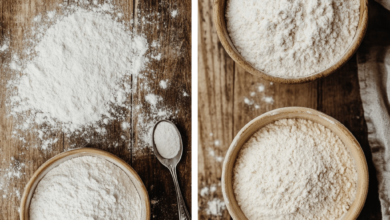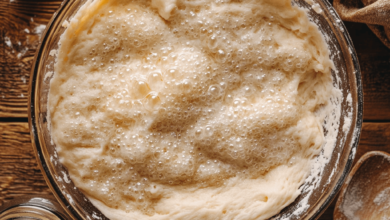What Is Proofing in Baking and Why Is It Important?
Introduction
“What is proofing in baking, and why does it matter?”
Proofing, also known as fermentation, is a crucial step in bread baking that allows dough to rise and develop flavor. This process involves yeast activity, which produces gases and enhances the dough’s texture, structure, and taste. In this guide, we’ll explore what proofing is, why it’s important, and how to master it for perfect baked goods.
1. What Is Proofing in Baking?
Proofing refers to the process of letting yeast dough rest and rise before baking.
- How It Works:
- Yeast consumes sugars in the dough and produces carbon dioxide (CO₂) and alcohol.
- The CO₂ creates gas bubbles that expand the dough, while alcohol adds complexity to the flavor.
- Types of Proofing:
- Bulk Proofing: The first rise, where the entire dough mass ferments.
- Final Proofing: The second rise, after shaping the dough into its final form.
2. Why Is Proofing Important?
Proofing is essential for achieving:
- Volume: The gas bubbles created by yeast expand the dough.
- Texture: Proper proofing creates a light, airy crumb.
- Flavor: Alcohol and organic acids produced during fermentation enhance the taste.
Tip: Overproofing or underproofing can ruin the texture and flavor, so timing is key.
3. How to Proof Dough
Follow these steps for successful proofing:
1️⃣ Prepare the Dough
- Knead the dough until it’s smooth and elastic, ensuring gluten development.
2️⃣ Choose a Proofing Spot
- Opt for a warm, draft-free environment, ideally around 75–85°F.
3️⃣ Cover the Dough
- Use a damp towel or plastic wrap to keep the surface from drying out.
4️⃣ Monitor the Dough
- The dough should double in size during proofing. This typically takes 1–2 hours, depending on the recipe and environment.
4. Common Mistakes and How to Avoid Them
- Overproofing:
- Dough rises too much and collapses, resulting in a dense texture.
- Solution: Stick to recommended proofing times and check the dough regularly.
- Underproofing:
- Insufficient rising leads to a dense, heavy crumb.
- Solution: Ensure the dough doubles in size before proceeding.
- Temperature Issues:
- Cold environments slow down yeast activity, while excessive heat kills the yeast.
- Solution: Use a warm, stable environment for proofing.
5. Tips for Perfect Proofing
- Use a Proofing Box: If you bake often, a proofing box provides consistent temperature and humidity.
- Check with the Finger Test: Gently press the dough with your finger—if it springs back slowly, it’s ready.
- Try Cold Fermentation: Proofing in the fridge overnight enhances flavor and texture.
Conclusion
Proofing is a vital step in baking that transforms dough into light, flavorful bread. By understanding the science and mastering the techniques, you can achieve perfect results every time. Whether you’re a beginner or an experienced baker, proper proofing is key to elevating your bread-making skills.
For more baking tips and techniques, visit our Kuestion.com.




